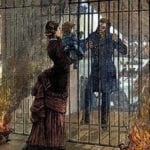 Mysteries
Mysteries  Mysteries
Mysteries  History
History 10 Surprising Stories About the Texas Rangers
 Humans
Humans 10 Philosophers Who Were Driven Mad by Their Own Theories
 Miscellaneous
Miscellaneous 10 Video-Game-Worthy Weapons and Armors from History
 Weird Stuff
Weird Stuff 10 Psychics Who Accurately Predicted Wartime Events
 The Arts
The Arts 10 Pieces of Art Inspired by a Broken Heart
 Health
Health 10 Science Fiction-Sounding New Medical Treatments
 History
History 10 Surprising Facts About the Father of Submarine Warfare
 Space
Space Ten Astonishing New Insights into Alien Worlds
 Weird Stuff
Weird Stuff 10 Bizarre Summer Solstice Rituals Still Practiced Today
 Mysteries
Mysteries Top 10 Haunting Facts About the Ghost Ship MV Alta
 History
History 10 Surprising Stories About the Texas Rangers
 Humans
Humans 10 Philosophers Who Were Driven Mad by Their Own Theories
Who's Behind Listverse?

Jamie Frater
Head Editor
Jamie founded Listverse due to an insatiable desire to share fascinating, obscure, and bizarre facts. He has been a guest speaker on numerous national radio and television stations and is a five time published author.
More About Us Miscellaneous
Miscellaneous 10 Video-Game-Worthy Weapons and Armors from History
 Weird Stuff
Weird Stuff 10 Psychics Who Accurately Predicted Wartime Events
 The Arts
The Arts 10 Pieces of Art Inspired by a Broken Heart
 Health
Health 10 Science Fiction-Sounding New Medical Treatments
 History
History 10 Surprising Facts About the Father of Submarine Warfare
 Space
Space Ten Astonishing New Insights into Alien Worlds
 Weird Stuff
Weird Stuff 10 Bizarre Summer Solstice Rituals Still Practiced Today
10 Bleak Facts about Victorian Workhouses
Unless you were wealthy, living through the Victorian era was likely to be a bleak and miserable time. But, there was one word in particular that would strike fear into the hearts of the poor and unemployed: workhouse.
Workhouses were institutions that provided accommodation and work for poor, old, or unemployed people, but many considered them to be a last resort. Why? What was so terrible about these establishments, and how were they run? Read on to discover 10 somber facts about life in a Victorian workhouse.
Related: 10 Gruesome And Shocking Facts About Victorian Surgery
10 Established through the Poor Law of 1834
Until 1834, looking after poor people was becoming increasingly expensive. Middle and upper-class citizens paid for these costs through taxes. However, these classes began to feel like they were simply paying poor people to be lazy and not work.
After numerous complaints, a Poor Law was passed in 1834. Many people supported this new law because they thought it would make it cheaper to look after poor people and encourage them to work to support themselves.
This new Poor Law meant that parishes were put into union groups, with each union being required to open a workhouse if they hadn’t done so already. Apart from special circumstances, the only way for poor people to get help was if they went to live and work in a workhouse. However, not everyone supported the concept of workhouses, with some people branding them as “prisons for the poor.”[1]
9 Cruel and Unsanitary Conditions
The harsh reality of workhouses became synonymous with the Victorian period—an era known for its dire conditions, long working hours, forced child labor, malnutrition, and beatings. Workhouses would have prison-like conditions, so it’s easy to see why they were so hated and feared by many.
Simply surviving in these places proved to be difficult—death rates were high, with diseases such as measles and smallpox spreading quickly. The sleeping conditions were awful, too, with the beds being squashed together with barely any room for each person and little to no light.
When the inmates weren’t sleeping, they were expected to work. The factory-style production lines were unsafe and were only focused on profit instead of solving the issue of poverty.[2]
8 Medical Care in a Workhouse
If you had no choice but to enter a workhouse and fell ill, bad news! Up until the 1870s, the medical care inside these establishments was appalling. Most workhouses had infirmary rooms where sick patients were treated, but they were usually far too small, poorly ventilated, and extremely unhygienic.
Patients were all mixed together, regardless of how ill they were, and some even had to share beds! Under the Poor Law, workhouses were required to have at least one qualified medical officer to treat sick inmates, but this usually didn’t happen as the job post wasn’t particularly attractive.
Early on, medical care was frequently provided by female workhouse inmates. Unfortunately, these women were often unable to read. Also, they were frequently drunk—an extremely bad combination when they were responsible for the patient’s health and well-being! Shockingly, before 1863, no trained nurses were employed by workhouses outside London.[3]
7 Children in the Workhouse Had It Bad Too
The conditions that children were subjected to in the workhouses were dire. In 1838, a physician visited a workhouse in Whitechapel, London, and his findings were shocking. He visited the infant nursery in which 23 pale and unhealthy-looking children, all aged around two to three years old, were kept in the same room and were rarely taken outside for fresh air or exercise.
In another section of that workhouse, 104 girls were found to be sleeping four, or sometimes more, to a bed in a room that was just 7 feet (2.1 meters) high, 16.5 feet (5 meters) wide, and 88 feet (26.8 meters) long. Although there were strict rules around corporal punishment against children, there were still many cases of cruelty against young inmates.
One case involved a little boy of around eight years old being flogged for three days because he complained to his guardians that he had been unjustly beaten. Other cruelty cases included a 13-year-old girl being beaten for leaving some dirt in the corner of a room and an eight-year-old boy being placed in a bag and suspended from a beam.[4]
6 Families Were Separated
Not only were workhouses miserable and disease-ridden places, but families who entered them were cruelly split up. This was a deliberate policy where husbands and wives were kept apart to stop them from “breeding.” Middle-class citizens would use this term as they believed the poor had a lot of children to claim more money.
Children were kept separate from their parents in the workhouse as it was believed this would turn them into useful workers, unlike the parents. The general belief was that the mother and father couldn’t possibly be useful; otherwise, they wouldn’t have needed to enter a workhouse in the first place.
There were four categories of prisoners in the workhouses—the elderly and impotent, children, able-bodied men, and able-bodied women. Each category had its own dormitory, day room, and exercise yard. Although family members might have seen each other in the chapel or during meal times, they weren’t allowed to speak with each other.[5]
5 Workhouse-Related Scandals
Unfortunately, the workhouses were the subject of many scandals over the years. One case happened in 1845 in the Andover workhouse, with the master and his wife running the institution like a brutal penal colony.
The conditions were so dire that inmates began purposefully committing crimes so they would be sent to prison, where the conditions were better. A guardian saw the male inmates fighting over bones that were supposed to be ground down and turned into fertilizer. The inmates were so famished that they began picking the gristle and marrow from rotting bones.
It was discovered that the inmates were on a starvation diet while being forced to use 28-pound (12.7-kilogram) “rammers” to crush rotten bones. The workhouse master thought this arrangement was financially beneficial as he purchased the bones for 17 shillings per ton and sold the crushed bones for 24 shillings per ton.
Another scandal happened in the Huddersfield workhouse in 1848. The inmates reportedly went without a change of bedding for nine weeks. The beds that typhus patients died in were used again and again for other patients without any attempt at making them hygienic. Even worse, the beds were simply bags stuffed with straw and were full of lice.
Patients with infectious fevers were frequently made to share a bed, and there was even a case of a live patient sharing a bed with a corpse![6]
4 Those Who Died in the Workhouse
If an inmate died in a workhouse, their family would have been notified so they could arrange the funeral. However, if the family couldn’t afford a funeral, the workhouse staff would arrange a burial in a nearby cemetery.
They would use the cheapest coffin possible, and the body would be buried in an unmarked grave—sometimes in unsacred ground![7]
3 Workhouse Punishment
Workhouses were disciplined institutions, and each one would have had its own set of rules which the inmates had to abide by. These rules were displayed inside the workhouse, and they were frequently read out aloud so that even the illiterate inmates had no excuse for misbehaving.
Inmates who failed to abide by these strict rules were severely punished, with offenses being grouped into two categories—disorderly and refractory.
Disorderly behavior included making too much noise, disobeying orders, swearing, and escape attempts. These offenses were typically punished by taking away “luxury” items such as tea or butter. The offending inmates were usually punished with a bland diet of bread and potatoes too.
Refractory behavior was classed as assaulting staff members or other inmates, getting drunk, property damage, or inappropriate behavior. The punishment for refractory behavior was usually solitary confinement, with severe cases being taken to the Justice of the Peace.
Child punishment was usually carried out inside the workhouse. Cases include two six-year-old boys in a Hereford workhouse being caned for sleeping during Sunday Service. Eight boys were also flogged for throwing water at the schoolmaster and kicking him.[8]
2 Long and Monotonous Days
If you were unlucky enough to have to enter a workhouse, every day would have been the same. A workhouse day typically began with the rising bell sounding between 6 and 7 am, depending on whether it was summer or winter.
Breakfast would have been at 6:30 am, and work would commence at 7 am. One hour was allowed for lunch from midday to 1 pm, and the work day would continue until 6 pm, with supper being from 6 to 7 pm. There was no choosing your own bedtime, though—you’d be required to be in bed at 8 pm!
The types of duties performed were different for male and female inmates. Men were usually given tasks such as crushing bones, picking oakum, or breaking stones. Women typically did chores such as laundry, cooking, and sewing.[9]
1 Mundane and Unvaried Food
There was no smashed avocado on sourdough in the workhouse! Under the 1834 Poor Law, the rules around which foods inmates could eat were strict. Breakfast and supper usually consisted of bread and cheese or porridge. For lunch, it was typically soup or meat and potatoes, but sometimes suet or rice pudding was served instead.
The women and children were served less than the men. The elderly inmates were usually allowed a ration of butter, sugar, and tea every week for breakfast and supper. But overall, the workhouse diet was extremely bland and lacking in variety. No fruits or vegetables were provided, which meant the inmates were missing essential vitamins and minerals.
This bland diet was designed to give the minimum needed to keep the inmates alive and also to deter people who didn’t need to enter the workhouse.[10]








